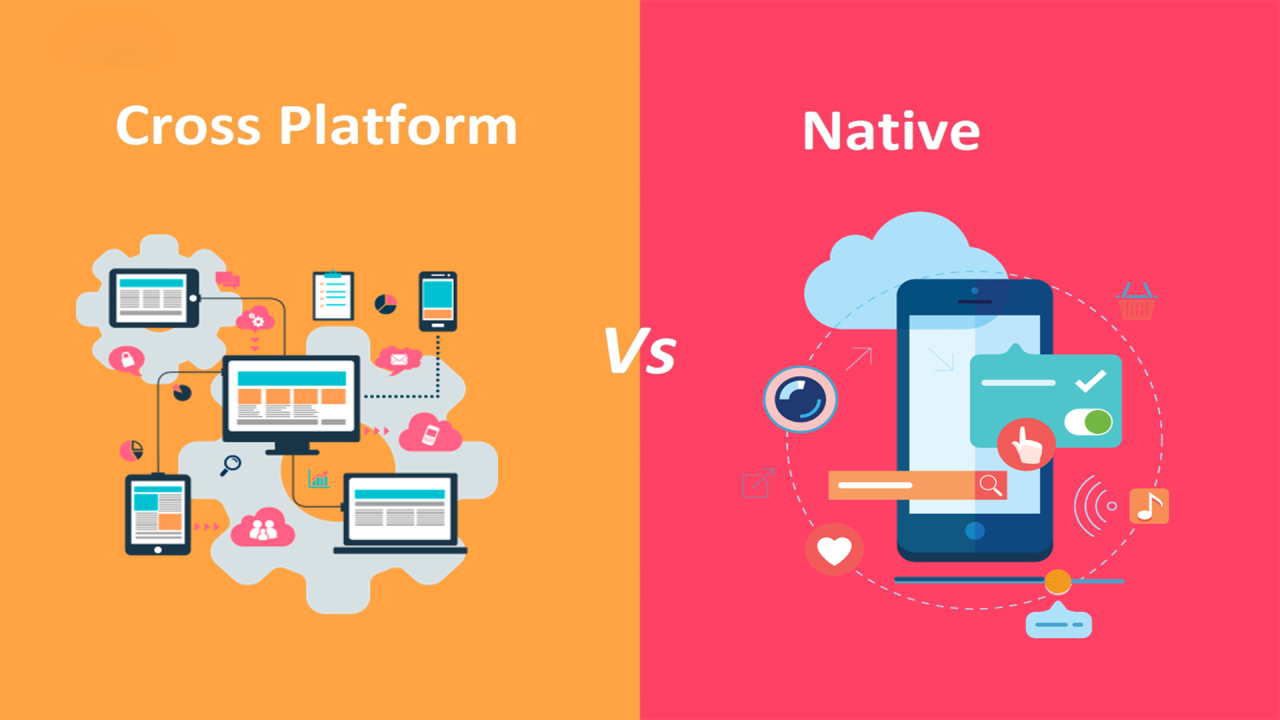In the ever evolving world of app development, the question of Native vs. Cross-Platform is like asking whether to buy a sports car or an SUV. Both will get you where you want to go, but the journey will feel entirely different. So, how do you decide which route to take when launching your mobile app?
The truth is, the choice between Native and Cross-Platform development is one of the most important decisions you’ll make as an app developer. Each option has its strengths and weaknesses, and the right choice for you depends on your project’s goals, timeline, and budget.
Let’s take a creative dive into this decision-making process to help you navigate the landscape and choose the best path for your app’s journey.
What Is Native and Cross-Platform Development?
Before diving into the nitty-gritty, let’s quickly define these two terms to level the playing field.
- Native Development refers to building an app specifically for one platform, using the language and tools native to that platform. For iOS, this means using Swift or Objective-C, while Android apps are built using Java or Kotlin. Native apps are known for high performance, robust user experiences, and deep integration with platform-specific features.
- Cross-Platform Development, on the other hand, involves writing code that can run on multiple platforms (both iOS and Android) using a single codebase. Frameworks like React Native, Flutter, and Xamarin have made cross-platform development popular by simplifying the process of reaching both audiences with one project.
Now that we’ve set the scene, let’s get to the real question: How do you choose between the two?
1- The App Performance Showdown
Imagine you’re hosting a performance show. On stage are two contestants: Speedy Native and Resourceful Cross-Platform. Both have their strengths, but which one wins the performance crown?
Native Development: Built for Speed and Precision
Native apps are like precision sports cars. They’re fine tuned to take advantage of everything the platform offers. Since native apps are built specifically for one operating system, they can use the full power of the device’s hardware—like the camera, GPS, and even the device’s storage. This leads to faster load times, smoother animations, and better overall performance.
If your app requires high performance graphics, real time processing, or advanced animations, such as in gaming apps or those that need a lot of processing power, native development can make the process easy. It delivers a seamless user experience because everything is optimized for that particular platform.
In fact, research from Statista shows that 78% of users are more likely to recommend an app with fast loading times. So, if user experience and speed are at the core of your app’s success, native development has a clear edge.
Cross-Platform Development: One Codebase, Multiple Roads
Cross-platform apps might not offer the same level of performance as their native counterparts. However, they’re incredibly resourceful. Imagine a multitool in your pocket that works just fine on different terrains. Cross-platform frameworks use a single codebase to deliver an app for both iOS and Android, which can cut down development time significantly.
For most business apps, like e-commerce, social networking, and utility apps, the performance gap between native and cross-platform is minimal. Cross-platform tools like Flutter have come a long way in reducing this gap by offering near-native performance while allowing for code reuse across platforms.
2- Time, Budget, and Resources—The Resource Allocation Dilemma
When you’re trying to balance project timelines and budget constraints, it feels like you’re juggling flaming swords. Let’s talk about how each approach handles your most precious resources: time and money.
Native Development: Quality Comes with a Price
Building separate apps for iOS and Android means double the code, double the effort, and double the cost. You’ll need two teams with expertise in each platform’s language and development environment.
According to Clutch, the cost to build a simple app can range from $25,000 to $50,000, and more complex apps can reach $100,000 or higher. Native apps generally take longer to develop because everything has to be built from scratch for each platform. That said, the result is often higher quality, with fewer bugs and smoother user experiences.
If you have a large budget and a dedicated development team for both platforms, native development offers flexibility and control over every aspect of your app. But for small startups or businesses on a tight budget, the price tag of native apps can feel overwhelming.
Cross-Platform Development: The Budget Friendly Alternative
Cross-platform development allows you to get an app up and running on multiple platforms with one codebase, which drastically reduces the development time and cost. According to Good Firms, the average time to develop a well built cross-platform app can be up to 30% faster than developing separate native apps.
For companies on a tight budget or those who need to launch quickly, cross-platform is a great option. You’ll only need one team of developers who specialize in frameworks like React Native or Flutter, and you can deliver your app to a wider audience without burning through your budget.
However, keep in mind that while cross-platform development saves time and money, it may come with trade-offs in performance—particularly when accessing platform-specific features.
3- User Experience (UX)—The Heart and Soul of Your App

When it comes to app success, the user experience is king. A seamless, intuitive experience can be all the difference between users loving your app or abandoning it altogether. Let’s see how native and cross-platform stack up in delivering that perfect UX.
Native Development: Tailored for Each Platform
Native apps are like custom-made suits—they fit perfectly with the platform’s design language, making them feel familiar and intuitive for users. Whether it’s Material Design for Android or Human Interface Guidelines for iOS, native apps offer a user experience that feels right at home on the platform.
This approach is especially important if you’re building an app that needs to align closely with platform-specific design patterns or if you want to take advantage of cutting-edge platform features as soon as they’re released.
For example, if you’re building an iOS app, you can quickly integrate the latest features announced by Apple during WWDC, ensuring your app stays cutting-edge. On Android, you’ll have the freedom to leverage widgets and home-screen experiences that Android users love.
Cross-Platform Development: One Size Fits Most
Cross-platform apps offer a more universal experience across platforms, which can be both a strength and a weakness. While cross-platform frameworks do a good job of adapting to different platforms, they often lack the polished feel of native apps because they aren’t as deeply integrated with platform-specific features.
However, with improvements in frameworks like Flutter, which uses its own rendering engine, cross-platform apps are increasingly able to mimic the native look and feel. If your app’s UX needs are straightforward—like in an e-commerce or content app—cross-platform can often deliver a great experience with minimal trade-offs.
4- The Future-Proof Factor—Which One Will Stand the Test of Time?
When planning an app, you’re not just thinking about today. You’re planning for future updates, maintenance, and scalability. Let’s look at how native and cross-platform approaches fare when it comes to future-proofing your app.
Native Development: Always In The Spotlight
When you build natively, you have immediate access to the latest platform updates and features as soon as they are released. This means your app can stay relevant and updated with the latest tools and innovations from Apple and Google.
Additionally, native apps tend to be more scalable and easier to maintain over time, as each platform has dedicated resources and frameworks that developers can use for long-term updates.
If your app is feature-heavy and needs to stay on the cutting edge of technology, native development gives you the flexibility to adapt and evolve quickly.
Cross-Platform Development: Quick Updates, But Slower to Adapt
Cross-platform development frameworks rely on third-party tools to keep up with platform updates, which means they may lag behind when new features are rolled out. However, they still offer a faster time-to-market for smaller updates and bug fixes, which can be pushed to both platforms simultaneously.
If your app doesn’t rely heavily on cutting-edge features and you need quick iterations after launch, cross-platform development can work well. Just keep in mind that complex features or major platform changes may require significant workarounds.
The Verdict on Native vs Cross-Platform Development
So, which path should you choose—Native or Cross-Platform? Ultimately, the decision comes down to your app’s specific needs, your budget, your timeline, and your goals.
- Choose Native if you need high performance, a polished user experience, and deep integration with platform-specific features. Native apps are ideal for apps that rely on real-time data, advanced graphics, or the latest platform features.
- Choose Cross-Platform if you need to launch quickly, on a budget, and want to reach both iOS and Android users with a single codebase. This is perfect for business apps, social platforms, and e-commerce solutions where performance trade-offs are minimal.
Remember, the choice between native and cross-platform is not a one-size-fits-all decision. Consider the positives and negatives of both approaches based on your app’s needs, and whichever path you choose, ensure your users have the

